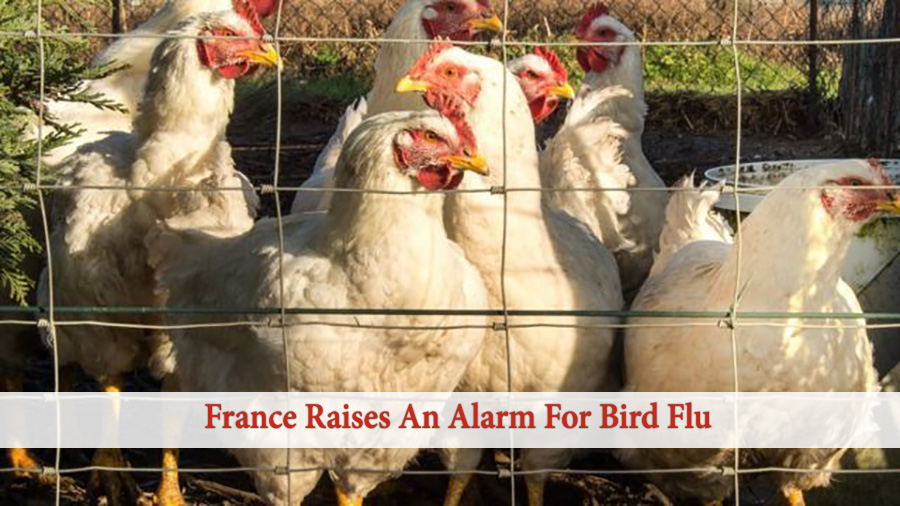
In between Coronavirus, France is putting part of the country on the high alert for the bird flu when the cases for this disease were reported in Western Europe since last month, the government has announced on Thursday. Around half of the administrative departments of France will be classed as a red alert, while the rest of the country will be on the medium alert, the government reported in a verdict published in its official journal.
The high alert level particularly needs poultry farms for keeping animals indoors or install protective meshwork to prevent contact with the wild birds which spread the disease. The government said in the verdict, “The availability of the virus in wild animals near the border of France, in a wandering channel which crosses national territory, defends the raising of the risk level”.
The measure helps to replace a previous verdict from late October which had boosted surveillance in the Wetland zones which grans the migrating birds. The Netherlands, the largest exporter of chicken meat and eggs in Europe, has ordered the culling of over 200, 000 chickens after highly pathogenic bird flu was found on the various farms since late October.
After reports of various cases of Bird Flu in Western Europe, France recently on November 4 has put parts of the country on high alert. The French government called to cull 200,000 chickens in the east of the country after the disease has spread across the wild animals near the border of France as we already discussed. As per the France 24 report, as many as 45 French departments were professed “high” risk among the fears of avian influenza spread first examined in the migratory birds.
According to an update reported in the official announcement, the migratory channel which crosses national territory attracts birds and it also has raided the risk level for France. Although France gas boosted the investigation in the Wetland zones, the federal government has taken steps towards the safety measures in the domestic birds as well as commercial poultry farms. France also increased the sanitary measured to control the outbreaks and also has introduced restriction zones warning the veterinary sectors about the zoonotic virus H5. Because of a surge in the cases examined in European countries, the Netherlands has conducted orders to reject all pathogenic birds in the poultry to prevent the sickness from mixing. Apart from this, the UK prompted an additional 13,000 birds to be culled at the Cheshire farm to curb infection from dispersal at the commercial locations.
Bird Flu is still not known to be transmitted to humans but certain strains are very contagious among poultry. Outbreaks in France in current years destroyed duck and then, goose flocks which are reared to generate the pate specialty foie grass.
UK Chief Veterinary Officer Christine Middlemiss said in a Press release that, “Bird keeper should remain alert for any disease sign, report suspected immediately and make sure that they are maintaining good biosecurity on their locations. She also added that, “we are urgently looking for any symptoms of disease spread linked with this farm to control and eliminate it”.
What are the symptoms of bird flu?
You might have an H5N1 infection if you face typical flu-like symptoms such as:
- Diarrhea
- Cough
- Headache
- Fever
- Respiratory difficulties
- Muscle aches
- Malaise and Runny nose
- Sore throat
If you are exposed to bird flu, you should alert staff before you arrive at the office or hospital of a doctor. Notifying them ahead of time will let them take precautions to safeguard staff and other patients before caring for you.
What causes bird flu?
However there are various types of bird flu, H5N1 was the first avian influenza virus for infecting humans. The first infection happened in Hong Kong in 1997. The outbreak was associated with dealing with infected poultry. H5N1 happens naturally in the wild waterfowl, but it can actually spread simply to domestic poultry. The disease is conveyed to humans via the connection with infected bird feces, secretions, or nasal secretions from the mouth or eyes.
Consuming properly cooked eggs or poultry from infected birds doesn’t communicate the bird flu, but eggs should never be helped runny. Meat is measured safe if it has been cooked to an internal temperature of 165 Deg F.
Bird to human transmission: Birds like geese, turkeys, and domestic chickens come in contact with the virus from water, food, or particles contaminated with the virus. The virus can be shed in the droppings of migratory birds since these are natural carriers and is able to continue for 3 months in cool temperatures. It can also survive in water at 0 deg C for more than 30 days and at 22 deg C for up to 4 days. Virus transmission from birds to humans happens once a person working closely with these animals inhales dust particles containing the virus or by other means.
In countries where live birds are sold in markets along with raised or pigs near pigs, the possibility of the virus recombining with other subtypes is excellent. It is because both avian and human viruses can infect the pigs and if a pig is infected with both viruses simultaneously then, different parts of the human and avian viruses can combine with each other. Further, the avian virus which has picked some genes from the human form of the flu virus is able to more simply cause the condition in humans. However the wide majority of human cases of the bird flu are the main result of direct contact with an infected bird, rare cases of the direct human-to-human spread have been described.







